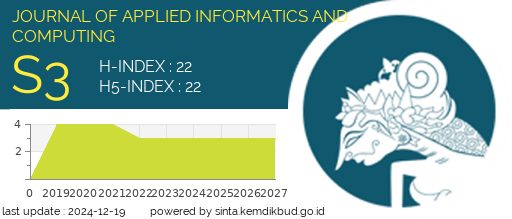Sentiment Analysis of User Reviews of the AdaKami Online Loan App from the App Store Using SVM and Naive Bayes
DOI:
https://doi.org/10.30871/jaic.v9i3.9536Keywords:
AdaKami, Apple App Store, Naive Bayes, Online Loans Sentiment Analysis, Support Vector Machine, TF-IDFAbstract
This study aims to classify sentiments on user reviews of the AdaKami online loan application, which are obtained through web scraping techniques from the Apple App Store platform. A total of 2000 reviews were collected, then selected and 1000 reviews were selected to be manually labeled by two linguistic experts, to ensure the validity of the classification. Sentiments are divided into three categories, namely negative, neutral, and positive. The classification model was built using two machine learning algorithms, namely Support Vector Machine (SVM) and Naïve Bayes (NB). The evaluation was carried out by measuring accuracy, precision, recall, F1-score, as well as through confusion matrix and cross-validation. The results showed that SVM performed better, with an accuracy of 97.5%, an F1-score of 0.97, and an average cross-validation accuracy of 84.69%. In contrast, Naïve Bayes recorded an accuracy of 81.4% and an F1-score of 0.77. The results of the paired t-test showed that the difference in performance between the two models was statistically significant (p < 0.05). The SVM model was then applied to predict 971 unlabeled reviews, and the results showed a dominance of negative sentiment. Wordcloud visualizations reinforced this finding, with words such as “bilih”, “bunganya”, and “teror” as the most frequently occurring words. These findings prove that SVM is more effective in classifying online loan review sentiments, as well as providing important insights for developers in understanding user perceptions and experiences.
Downloads
References
[1] M. Hafil, “AdaKami dorong perekonomian masyarakat Indonesia,” Republika Online, 2022. [Online]. Available:
[2] D. Febriana, A. N. Putri, dan R. A. Santoso, “Perbandingan algoritma dalam analisis sentimen aplikasi,” Jurnal Informatika dan Komputasi, vol. 10, no. 3, 2023.
[3] R. A. E. Wahyuni dan B. E. Turisno, “Praktik finansial teknologi ilegal dalam bentuk pinjaman online ditinjau dari etika bisnis,” Jurnal Pembangunan Hukum Indonesia, vol. 1, no. 3, pp. 379–391, 2019.
[4] D. N. Sastradinata, “Aspek hukum lembaga pinjaman online ilegal di Indonesia,” Jurnal Independent, vol. 8, no. 1, p. 293, 2020.
[5] Kementerian Keuangan, “Laporan fintech lending di Indonesia,” 2021.
[6] S. R. Irawan, L. Humaira, dan S. A. Sjarif, “Peran AdaKami dalam akses pinjaman tanpa jaminan,” Lex Patrimonium, vol. 3, no. 1, pp. 1–17, 2024.
[7] M. Raharja dan B. Sulistyo, “Analisis sentimen ulasan aplikasi media berita online,” Jurnal Informatika dan Sistem Informasi, vol. 8, no. 4, pp. 45–53, 2021.
[8] A. Yulianto dan D. Kurniawan, “Analisis sentimen ulasan aplikasi dengan algoritma Naïve Bayes: Studi kasus pada platform E-Commerce,” Jurnal Sistem Informasi, vol. 16, no. 1, pp. 45–56, 2024.
[9] A. Sasmitha dan B. Harto, “Analisa perhitungan suku bunga pinjaman harian pada aplikasi pinjaman online legal menggunakan metode simple interest,” ATRABIS, vol. 7, no. 2, pp. 132–139, 2021.
[10] F. H. Setiawan, I. P. Radjamin, dan M. Ariani, “Pinjaman online: Perilaku konsumtif mahasiswa Surabaya dalam menunjang status sosial,” MSEJ, vol. 5, no. 1, pp. 413–425, 2023.
[11] H. Putra dan L. Rahmawati, “Analisis sentimen pada tweet tentang pinjaman online menggunakan metode Random Forest,” Jurnal Informatika dan Komputasi, vol. 14, no. 3, pp. 213–220, 2022.
[12] B. Pang dan L. Lee, “Opinion mining and sentiment analysis,” Foundations and Trends in Information Retrieval, vol. 2, no. 1–2, pp. 1–135, 2008.] C. Cortes dan V. Vapnik, “Support-vector networks,” Machine Learning, vol. 20, no. 3, pp. 273–297, 1995.
[13] N. Cristianini dan J. Shawe-Taylor, An Introduction to Support Vector Machines and Other Kernel-based Learning Methods, Cambridge University Press, 2000.
[14] F. A. Indriyani, A. Fauzi, dan S. Faisal, “Analisis sentimen aplikasi TikTok menggunakan algoritma Naïve Bayes dan Support Vector Machine,” TEKNOSAINS, vol. 10, no. 2, pp. 176–184, 2024.
[15] Rahayu, I. P., Fauzi, A., & Indra, J. (2022). Analisis sentimen terhadap program Kampus Merdeka menggunakan Naive Bayes dan Support Vector Machine. Jurnal Sistem Komputer dan Informatika (JSON, 4(2), 296–301.
[16] Y. Cahyana and A. M. Siregar, “Analisis Sentimen Pembelajaran Tatap Muka Terbatas (PTMT) Selama Pandemik COVID-19 Menggunakan Algoritma Naïve Bayes,” Petir: Jurnal Teknik dan Rekayasa, vol. 16, no. 2, pp. 200–211, 2023.
[17] F. N. Azzahra, T. Rohana, R. Rahmat, and A. R. Juwita, “Penerapan Metode Naive Bayes Dalam Klasifikasi Spam SMS Menggunakan Fitur Teks Untuk Mengatasi Ancaman Pada Pengguna,” Journal of Information System Research (JOSH), vol. 5, no. 3, pp. 873–880, 2024.
[18] M. F. Haikal, J. Indra, dan R. Rahmat, “Analisis sentimen bakal calon presiden Indonesia 2024 dengan algoritma Naïve Bayes,” JUTISI, vol. 13, no. 1, pp. 43–51, 2024.
[19] A. Adela, F. Nurjanah, dan R. Setiawan, “Analisis sentimen ulasan aplikasi pinjaman online,” Jurnal Teknologi Informasi dan Komunikasi, vol. 15, no. 2, pp. 112–125, 2023.
Downloads
Published
How to Cite
Issue
Section
License
Copyright (c) 2025 Wava Lativa Azzahra, Jamaludin Indra, Rahmat Rahmat, Sutan Faisal

This work is licensed under a Creative Commons Attribution-ShareAlike 4.0 International License.
Authors who publish with this journal agree to the following terms:
- Authors retain copyright and grant the journal right of first publication with the work simultaneously licensed under a Creative Commons Attribution License (Attribution-ShareAlike 4.0 International (CC BY-SA 4.0) ) that allows others to share the work with an acknowledgement of the work's authorship and initial publication in this journal.
- Authors are able to enter into separate, additional contractual arrangements for the non-exclusive distribution of the journal's published version of the work (e.g., post it to an institutional repository or publish it in a book), with an acknowledgement of its initial publication in this journal.
- Authors are permitted and encouraged to post their work online (e.g., in institutional repositories or on their website) prior to and during the submission process, as it can lead to productive exchanges, as well as earlier and greater citation of published work (See The Effect of Open Access).











